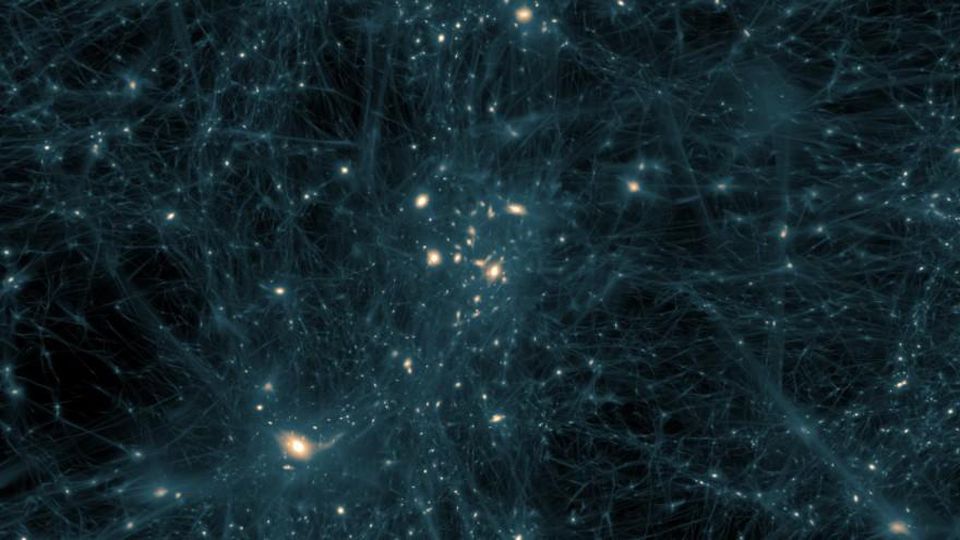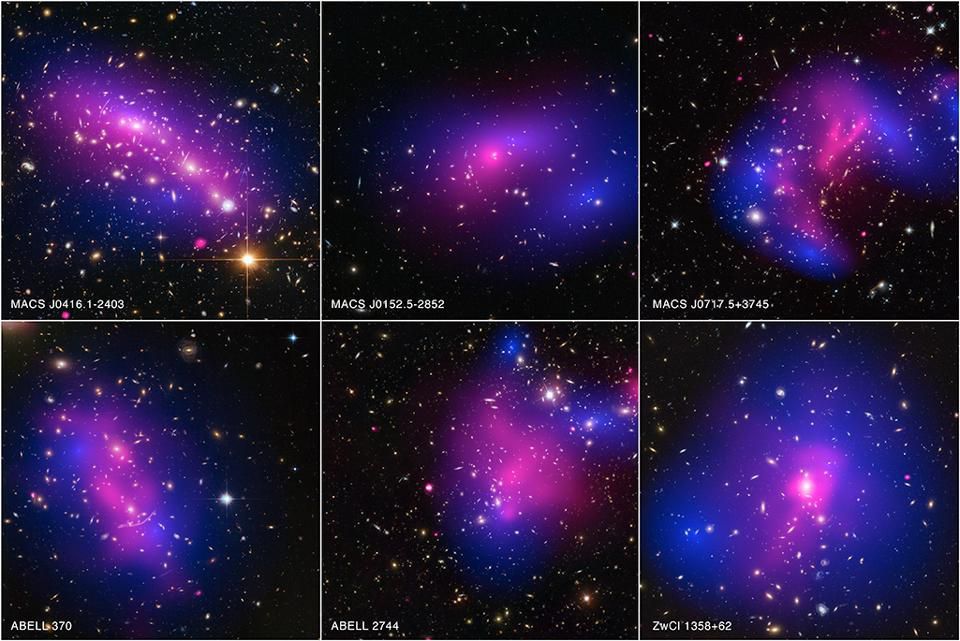The merger of neutron stars put an end to alternatives to dark matter and dark energy
- Transfer

In the last moments of the merger, two neutron stars do not just emit gravitational waves — there is an explosion of catastrophic power that responds over the entire electromagnetic spectrum. The difference in arrival time between light and gravitational waves allows us to learn a lot about the universe.
Ask astrophysics about the greatest mystery of the universe today - and the two most frequent answers will be "dark matter" and "dark energy." What constitutes everything on our Earth, atoms, which in turn consist of fundamental particles, make up only 5% of the cosmic energy budget. And either 95% of the energy of the Universe is contained in these two forms, in the form of dark matter and dark energy, which have not been directly observed to this day, or something fundamentally wrong with our understanding of the Universe. Alternatives to these theories have been studied for quite a long time, and their various variants have led to slightly different physical consequences. After the first time we observed the merging of neutron stars and received signals in the form of gravitational waves and light of a rather wide spectrum, a huge part of these alternatives was rejected.

The ultramassive dynamic galactic cluster Abell 370 , whose gravitational mass (and for the most part it is dark matter) is marked in blue.
In astrophysics and cosmology there are several large puzzles that dark matter and dark energy should solve. In the part of dark matter, they are mostly associated with the formation, rotation and accumulation of galaxies, and in the part of dark energy they are associated with the rate of expansion of the Universe and its evolution in time. Some of the observations can be justified by slightly refining the theory of gravity., and it does not require dark matter and dark energy. The people working on these modifications hope that they will find one, the right one - one that can also make new predictions that differ from the predictions of the theories of dark matter and dark energy - and that they can be tested.

The formation of the cosmic web is controlled by dark matter, and the most large-scale structures - the speed of expansion and dark energy. Small structures located along the filaments are formed due to the collapse of ordinary matter, subject to electromagnetic interactions.
But modifying gravity, whether trying to explain dark matter or dark energy (not to mention explaining both theories at once), is a game that needs to be played very carefully. Einstein’s general theory of relativity was already comprehensively tested, and her predictions were fulfilled each time. By modifying gravity, you change this theory, so it must be done in such a way that it does not contradict all the observations and measurements already made. As a result, many variants of change went to an area that was still not well tested: one that allows the speed of propagation of gravity to change. In Einstein's theory, the speed of gravity is equal to the light, always and accurately. But in many alternative theories, this assumption is changed.

Large-scale projection in the Illustris project simulation at the displacement z = 0, with the center in the most massive cluster at a depth of 15 Mpc / h [h is the dimensionless Hubble parameter / approx. trans.]. Demonstrates the transition of dark matter density (left) to gas density (right). The configuration of large-scale structures of the Universe cannot be explained without dark matter, although attempts are made to modify gravity.
It is usually assumed that dark energy is a cosmological constant, and that the speed of light and gravity are also constant (and equal to each other). Alternative formulations add something more complicated: a scalar field or a set of additional fields. This is a common place for modification models such as the Galilean covariant, massive gravity, gravity with massive graviton , Einstein ether theory , tensor-vector-scalar gravity , Horava gravity . In many cases, depending on how the scalar field interacts with the standard gravitational (tensor) field of the General Theory of Relativity, the speed of gravity is obtained either different from the speed of light or varying in time. But the fact that gamma rays and gravitational waves from the GW170817 event of neutron star fusion came with a difference of 1.7 s means that the speed of gravity should be equal to the speed of light with an error of no more than 10 -15 .

All massless particles move at the speed of light, including photons, gluons and gravitational waves, and carry electromagnetic, strong nuclear and gravitational interactions, respectively. The practical coincidence of the arrival times of gravitational and electromagnetic waves from GW170817 is extremely important.
As a result , a large number of alternatives to standard GTR with standard dark energy were disproved . The fact that the 1.7 s difference between the light and the gravitational signal at a distance of 130 million light years is so small means that the speed of gravity cannot change over time, or be systematically greater or less than the speed of light. By adding a scalar field to the tensor theory of gravity, you get two main effects:
- The tensor term of the additional velocity appears, increasing the speed of propagation of gravitational waves.
- The scale of the effective Planck mass changes on the cosmic masters of the time, which changes the attenuation of gravitational waves as the Universe expands.
The fact that the speed of light and the speed of gravity are equal with such precision suggests that all theories with modifications of this type are seriously limited, and that the majority of such models are, in fact, disproved.

Many modifications of gravity that reject dark energy have been refuted by the arrival time of gravitational and electromagnetic waves.
In the case of dark matter, attempts to create modified gravity had even worse . Most of the modifications change the law of interaction of massive objects, which changes the gravitational potential in the regions of space-time containing mass. When objects moving at the speed of light, such as photons or gravitational waves, pass through this space, these signals are slowed down according to the rules of general relativity: the Shapiro effect. At a distance of 130 million light years, the matter in the path must hold up this signal for about three years, if the standard idea of dark matter is true. But if you change gravity so as to get rid of dark matter, you seriously change the propagation properties of gravitational waves through space.

When light, gravitational waves, or any massless particle passes through a portion of space containing a large amount of matter, the path is curved due to the distortion of this space, which leads to a delay in arrival time. Most modified gravity theories will have different delays for light and gravity waves.
In modified theories of gravity without dark matter, such as TeVeS or MoG / Scalar-Tensor-VectorThere is a peculiarity - the gravitational waves in them propagate along geodesic curves - different paths in spacetime - different from those followed by photons and neutrinos. In short, gravitational waves must travel along paths determined only by normal matter, and photons and neutrinos must travel along paths determined by the effective mass: normal matter in total with the effects emulating dark matter. Such a difference would lead to the presence of a difference in the arrival time of photons and gravitational waves of approximately 800 days, rather than 1.7 seconds observed in reality.
Given the cross-correlation of gravitational waves and electromagnetic signals, these options without dark matter are refuted .

Various sources of mass in NGC 4993, where neutron star fusion occurred, and their effect on the delay in the passage of light and gravitational waves
When gravitational waves and photons (electromagnetic waves) propagate in space, the curvature and expansion of space affects them in exactly the same way. That is, while you use GRT. If you change the theory of gravity - to try to get rid of dark matter and / or dark energy, for example - then only matter and its mass will affect gravitational waves, and modification effects will affect photons and other particles. Since gravitational waves and light signals from merged neutron stars arrived simultaneously, they moved through space at the same speed and experienced the same deceleration. Precision accuracy is enough to exclude leading candidates for a modified theory of gravity without dark matter.

X-ray maps (pink) and the total amount of matter (blue) of various colliding galactic clusters demonstrate a clear separation between normal matter and gravitational effects - one of the most convincing evidence for the existence of dark matter. Alternative theories now have to be so attracted that many find them just ridiculous.
There are still several strained models that retain hopes for modified gravity — for example, non-local theories of gravity (in which gravitational effects and mass distribution do not coincide), or theories in which gravitational waves and electromagnetic waves obey different rules. But even these ideas are seriously limited by new observations of gravitational waves, and they need more and more to resemble the effects of dark matter and dark energy in order to survive. Modified gravity has not yet sunk into oblivion, but many of its greatest hopes have just broken. Einstein, with his theory in its original, unchanged version, still lives.
